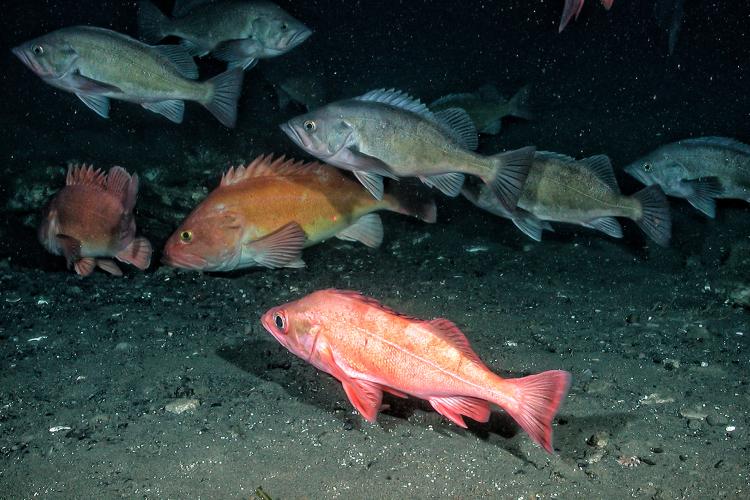We create various types of statistical models that incorporate ecosystem information such as predator-prey relationships, food web relationships, diet analysis and socio-economic data that is used to inform fishery management decisions for Alaska groundfish species. Each year ecosystem status reports are produced for the four Alaska marine ecosystems.
Overview of Activities
- Field collection and laboratory analysis: The program performs annual collection of groundfish stomachs in the eastern Bering Sea and biennial collections in the Gulf of Alaska and the Aleutian Islands and West Coast regions. About 15,000 stomachs are collected and analyzed annually. The groundfish food habits database contains over one million data records from over 400,000 stomachs collected since 1981, including historical collections off the west coast.
- Species level data analysis includes groundfish diet composition by season, size, and area. Various methods for estimating daily ration are used including detailed bioenergetic models of growth and consumption. Estimates of total annual predation on commercially important prey species by groundfish are produced and compared with marine mammal and bird consumption. Cooperative work with process-oriented field programs provides insight into predator functional feeding responses.
- Multispecies data analysis focuses on identifying physical and biological factors influencing diet overlap and competition among groundfish and other ecosystem components. Multivariate statistical analysis, diet overlap indices, and analysis of food web characteristics are used to identify feeding guilds and important habitat features. Ecosystem implications of current fishing, discard, and processing practices have been examined using data on consumption of discards by marine predators and rates of energy flow to the detritus. Indices of ecosystem status, e.g. species diversity, are also developed along with research focused on the development of indices showing the links between climate and fish production.
- Diverse modeling approaches are being used to quantify and understand predator/prey interactions. Predators (including mammals) have been incorporated into single-species catch-at-age models. Static energy balance models have been parameterized for different time periods. A multispecies virtual population analysis of eastern Bering Sea groundfish is being parameterized and tested. A dynamic upper-trophic level model of predation on juvenile pollock in the eastern Bering Sea is currently being planned with links to outputs of other agency modelling efforts such as physical transport models, individual-based models of juvenile pollock, and lower trophic level models of phytoplankton-zooplankton production.
- Seabird-fishery interactions are being quantified and fishing gear improvements to reduce seabird incidental catch are being evaluated. Standardized reporting, education, and outreach are important activities in understanding and reducing the incidental catch of seabirds in groundfish fisheries.
Future Directions
Improve Short-Term Yield Predictions
Current stock assessments predict on a single-species basis the short-term effects and yield obtained due to fishing pressure. However, these short-term projections tend to be based on fairly uncertain stock-recruitment relationships. Predation data will be incorporated into single-species stock synthesis models of Gulf of Alaska pollock and Bering Sea crab stocks in order to include pre-recruit mortality and to reduce recruitment uncertainty due to this mortality in our assessment process.
A multispecies virtual population analysis model where species are linked by predation has been parameterized for the eastern Bering Sea. We will be able to compare mortalities, abundances, and recruitments of fish populations obtained from this model with the single-species models currently being used for each species. New insights will be obtained on how production of commercially important species is affected by multispecies interactions.
Improve Long-Term Yield Predictions
Because most predation mortality occurs at young ages, the effects of multispecies interactions need to be assessed in the long-term. Strategic assessment of long-term consequences of various fishing strategies on the multispecies groundfish complex can be made through multispecies yield-per-recruit models and forecasting with results of the multispecies virtual population analysis model. These models will allow us to evaluate the effects of different fishing strategies on the total yield from the groundfish complex as a whole.
All predictions that rely on specifying spawner-recruit relationships can benefit from more research on reducing uncertainty in spawner-recruit relationships. Environmental and biological effects are often confounded in spawner-recruit data. More explicit spawner-recruit models that include both environmental and biological effects in their parameterization need to be developed.

